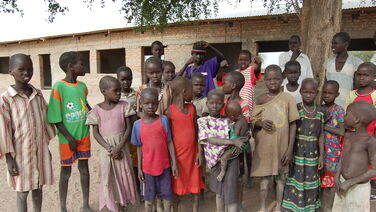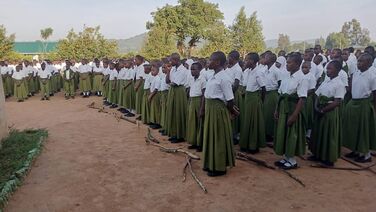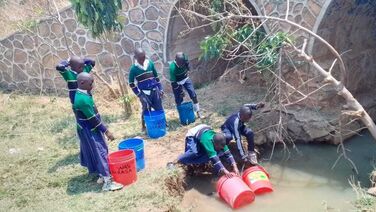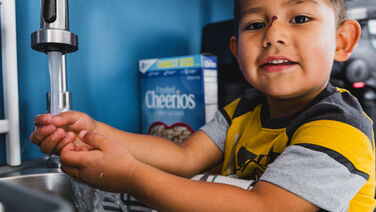
Sir Nimrod Infant & Junior School
Serving 224 students in Uganda’s Muyenje community as a private boarding and day school for primary and nursery students, Sir Nimrod Infant & Junior School currently relies on water from a traditional well but continually finds its needs unmet.

South Sudan School 1 (2026)
Our implementing partner, Water for South Sudan's, operations teams are based in Wau and work in remote villages in the Bahr el Ghazal region of South Sudan. These isolated villages have extremely limited access to clean water, and often can only access contaminated water that will lead to sickness or even death. WFSS works with local governments and community leaders to determine the placement of wells. The goal is to create sustainable systems, incorporating well maintenance and training as part of the installation of a well.

South Sudan School 2 (2026)
Our implementing partner, Water for South Sudan's, operations teams are based in Wau and work in remote villages in the Bahr el Ghazal region of South Sudan. These isolated villages have extremely limited access to clean water, and often can only access contaminated water that will lead to sickness or even death. WFSS works with local governments and community leaders to determine the placement of wells. The goal is to create sustainable systems, incorporating well maintenance and training as part of the installation of a well.

St. Charles Primary School
Background on Sierra Leone:The population includes many tribes including Mende and TemneThe capital of Freetown was formed by freed British slaves in the early 1800’sSierra Leone was a British Colony from the 1800s until 1961Extraction of minerals and wealth continues to this day, leaving the country in poverty1992-2002: Devastating Civil War followed by years of peace (ongoing)2014-2015: Ebola Outbreak with over 4,000 deaths and the loss of 10% of health care workersA democracy with a president and a parliament Demographics of Sierra Leone:Population: 8 MillionAverage age: 18Literacy: 35% for women; 51% for menHuman Development index:182 out of 189 countries3 doctors per 100,000 peopleLife expectancy: 55Maternal Mortality: 1 in 31 women, but improvingChild Mortality: 1 in 9 do not reach age 5Lembema is a village located three miles from Tikonko town and serves as the divisional head for approximately six surrounding villages. It is also one of our implementing partners, RHCI’s outreach clinic points. The village has a population of about 680 people, with the majority being youth and children. Most residents are subsistence farmers, primarily growing crops for personal consumption.

St. Stephen Chepsaga Secondary School
St. Stephen Chepsaga Secondary School is a mixed-gender institution established in 2014. The school is continuously developing, with ongoing infrastructure projects marking significant progress. Additionally, Chepsaga Secondary excels in agricultural practices, which are supported by a dedicated school farm and an active agriculture club, which enhance hands-on learning and sustainability efforts.Every day, the 174 students and 14 staff of St. Stephen Chepsega Secondary School go without sufficient water to meet their needs, causing an unneeded distraction that steals everyone's attention and time from their primary goal of learning.

Tanangozi Secondary School
Tanangozi Secondary School is a government institution situated in Mseke Ward, Iringa Region. Currently, the school enrolls a total of 874 students, including 459 girls and 415 boys, across Forms One to Four. The staff comprises 20 members, which includes both teaching and non-teaching personnel.

Ugwachanya Primary School
Ugwachanya Primary School is a government institution located in Mseke Ward, Iringa Region. The school has a total of 665 students and 18 staff members, which includes both teachers and non-teaching personnel. It plays a vital role in shaping the future of the community through education. However, it faces significant challenges due to a lack of a clean and reliable water source.

WASH for Batey Communities (phase 2)
The Dominican Republic is home to approximately 230 rural communities known as “bateyes” set up around state-run sugar mills, which once formed the economic backbone of this small Caribbean nation. The bateyes are socioeconomically isolated communities previously built by the government on sugar cane plantations to house cane cutters, mostly from neighboring Haiti. Today, both Haitians and their offspring and Dominicans live in the bateyes in extreme poverty with limited access to essential services, including clean drinking water—a fundamental human right.

Water Delivery #1 (2026)
On the Navajo Nation, 30% of families live without running water. They drive for miles to haul water to meet their basic needs and carefully ration water for drinking, cooking, cleaning, and bathing. Our implementing partner, DigDeep’s, Navajo Water Project, a locally-led, community-managed utility alternative, has been working to solve this injustice; by bringing working taps and toilets to families across the region.